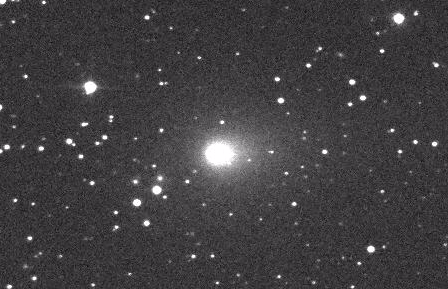Credit & Copyright: Gordon
Garradd. Used with permission.
Explanation:
Get ready for one of the most impressive but least anticipated light shows
in modern astronomical history. Next month, newly discovered
Comet
Hyakutake will pass closer to the Earth than any recent
comet. Unknown
before its discovery by Yuji Hyakutake on 30 January 1996, the fuzzy spot
in the above photograph is a
comet now
predicted to become bright enough to see without a telescope. Although
comets
act in such diverse ways that predictions are frequently inaccurate,
even conservative estimates indicate that this comet is likely to impress.
For example, even if
Comet
Hyakutake remains physically unchanged, its
close pass near the Earth in late March 1996 should cause it to appear to
brighten to about
3rd
magnitude - still bright enough to see with the unaided
eye. In the next two months, though, the
comet
will continue to approach
the Sun and hence should become brighter still. Optimistic predictions
include that
Comet Hyakutake
will change physically, develop a larger
coma and
tail,
brighten dramatically, move noticeably in the sky during a single
night, and may ultimately become known as the "The Great Comet of 1996."
Move over Hale-Bopp!
1999 2000 2001 2002 2003 2004 2005 2006 2007 2008 2009 2010 2011 2012 2013 2014 2015 2016 2017 2018 2019 2020 2021 2022 2023 2024 2025 |
Yanvar' Fevral' Mart Aprel' Mai Iyun' Iyul' Avgust Sentyabr' Oktyabr' Noyabr' Dekabr' |
NASA Web Site Statements, Warnings, and Disclaimers
NASA Official: Jay Norris. Specific rights apply.
A service of: LHEA at NASA / GSFC
& Michigan Tech. U.
|
Publikacii s klyuchevymi slovami:
comet - kometa Hiyakutake - kometnye hvosty - komety
Publikacii so slovami: comet - kometa Hiyakutake - kometnye hvosty - komety | |
Sm. takzhe:
Vse publikacii na tu zhe temu >> | |
